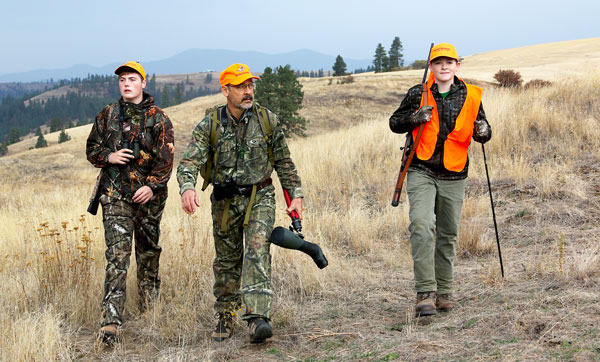By the time the sun rises at 6:10 a.m., Mitchell Sandquist is sitting in a patch of star thistles on a rocky slope. His 270 Winchester is perched in a shooting tripod and seems as eager as the boy holding it.
“Watch this side draw,” I whisper. “If a buck comes out of there, he’s only one hundred yards away. Just shift into shooting position slowly and he shouldn’t spook. I’ll keep watch to see if anything comes over the horizon.”
We scan a series of deer trails leading in and out of the canyons and side draws that cut through the Sandquist’s farm. Yesterday morning we watched three bucks forage and come within rifle range of this position. Last year, Mitch’s little brother Rhett shot his first buck within 200 yards of here. Mitch hopes to duplicate the feat but only with a bigger buck, because after all, he’s the older and bigger sibling.

The boys are the grandsons of my former neighbors, Ken and Lynda, two of the warmest, most helpful, welcoming, and cooperative people anyone could hope to know. I’ve hunted with Ken, his son Kevin, and now Ken’s grandsons. They are all ideal companions for the field, though Ken, at 82, these days does most of his hunting vicariously through Mitch and his brothers.
“Here comes one, Mitch!” I whisper. “Right along the edge of the field. He’s going to walk broadside from behind that patch of brush. Shift into position. He’ll be at one hundred fifty yards.”
The buck is a good 5×5 with antlers that would tickle most veteran hunters to collect. But soon there’s a complication—a furry one with gleaming teeth and an appetite for venison. The buck sees it, raises its tail, and prances across the field.
“Coyote!” Mitch hisses. He has more than one reason to dislike the wild dog. Last year, a pair messed up his chance at a buck near this very spot. They chased the deer from its path, which would have brought it within 200 yards of Mitch’s perch. Now it’s happening again.
“Stay on him in case he stops,” I whisper. But when the buck halts it does so directly in line with the sun burning over the horizon. The buck then jumps behind a big ponderosa pine and then emerges 350 yards away, showing its rump to the coyote and us.
“He went over into the canyon where you shot that coyote last year,” Mitch says.
“Looks like it. Wanna go after him or wait here and hope something else comes by?”
“Let’s go after him. He looked like a good one.”

We pick up our gear, unload the rifles, and plunge into the depths of the draw, ducking and bulling our way through the tangled brush. We emerge into a labyrinth of deer trails littered with droppings and tracks. When the coyotes aren’t on the prowl, the whitetails heavily use this travel lane. We follow the route and head for a big canyon about a quarter mile in the horizon.
“Hold it, Mitch,” I say, glassing during a breather. “Remember those four bucks I showed you on the far side of the canyon yesterday? They’re in the same place, only they’re coming down. Maybe they’re heading to the creek for water. If they keep moving and we get down there, we might get a two or three hundred-yard cross-canyon shot. Wanna try it?”
“Sure!”
We start down, fully exposed to our quarry, but more than 1,000 yards of deep canyon lie between us. If we can reach the brush along the canyon wall, we’ll have a chance to slip forward to a rocky bench overlooking the bottom quarter on the far side. The sun is already beaming on the opposite face, creeping behind the bucks as if pushing them into the shadows. We hurry to beat them to cover. Rocks roll and clatter, but we plunge ahead, fighting gravity just to stay upright.
Then we hit brush on our side and push through it, crushing leaves and snapping branches. Each time we stop to check on the deer, they’re deeper down, growing bigger by the minute. I don’t tell Mitch just how big they are for fear of infecting him with buck fever. From what I saw earlier, the buck’s rack would score in the mid-150s B&C, a fine trophy in anyone’s book.
“You okay?” I ask. Mitch has slid the last 10 yards of slope on his backside, sacrificing it to control his rifle. “Best pull that bolt and check the barrel, just in case.”
“It’s clear,” he says, after checking.
“Scope good?” We look everything over and it all seems well. “Okay, down to that rocky ledge jutting out there. We’ll crawl to the lip, I’ll lay my pack on the rocks and you can rest the rifle on it to shoot. Should be less than three hundred yards if they’re still in view. Ready?”
“Ready,” he says.
We start forward on the last 200 yards of our stalk. +++
Be sure to read Spomer’s first and second Dispatch from Idaho.
Photos by Ron Spomer

